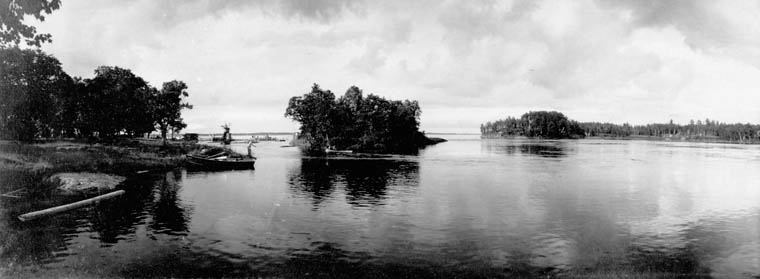Click on the green tab 1 to learn more about a word or phrase.
Find Du Vernet on a map.
Tuesday, July 12:
We arrived at Biscotasing 2 in the Diocese of Moosonee 3 at about 8:30. We saw the little Church where the Reverend J. Sanders 4 holds service. Mr. and Mrs. Sadler came to the station to see me. It is a lumber town on a pretty lake 5 . Later in the day we passed Missinabie 6 , where we saw another little Church where Mr. Sanders holds service. Many Indians 7 were camping by the lake here.
The trip around Jack Fish Bay 8 between 7 and 8 p.m. was most delightful. We could see Jack Fish as we got round to the other side, the water is 900 ft. deep.
Wednesday, July 13:
8 a.m. We are at Ignace 9 , a divisional point 10 . There are Indians here, part of the Wabigoon mission 11 .
We passed Dinorwic, and Wabigoon. The reserve is on Little Wabigoon Lake, south of Dinorwic station. At Eagle River 12 we saw two pretty little falls, and at Vermilion Bay 13 , we saw the wide expanse of Eagle Lake. 14 There is a reserve on this Lake 15 .
At about 1 p.m. we reached Rat Portage 16 and I called upon Mrs. John Chambers 17 (of the Church of England). Mr. Pither 18 (who was for 27 years an Indian Agent 19 ; it has been 61 years since he was first connected with the Hudson’s Bay 20 ) was not in when I called. I later learnt some valuable news from him, and also from Fred Carriff 21 . I saw Indians buying things in the shops, some whom had received their treaty money 22 , 5$ per head.
Mr. Page 23 was not at home so I went into St. Alban’s Church 24 . It was an intensely hot day. I went to Russel House 25 for tea 26 (which was 25 cents) and spent the evening with Mr. Pither (upon whom I had called twice and not found at home). He showed me the stone heads 27 of bow men’s arrows and spears, and a copper chisel 28 , which he had taken out of a mound 29 on his property on Rainy River. I also saw here the most beautiful beadwork 30 , which was transparent and done on a frame of strings, as well as a short, thick, Roman-looking sword from the battle of Cullodin 31 .

